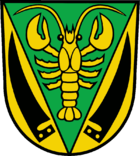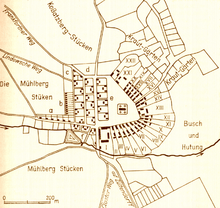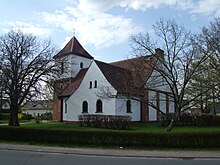Wiesenau
| coat of arms | Germany map | |
|---|---|---|

|
Coordinates: 52 ° 14 ' N , 14 ° 36' E |
|
| Basic data | ||
| State : | Brandenburg | |
| County : | Oder-Spree | |
| Office : | Brieskow-Finkenheerd | |
| Height : | 39 m above sea level NHN | |
| Area : | 29.74 km 2 | |
| Residents: | 1263 (Dec. 31, 2019) | |
| Population density : | 42 inhabitants per km 2 | |
| Postal code : | 15295 | |
| Primaries : | 033609, 033653 | |
| License plate : | LOS, BSK, EH, FW | |
| Community key : | 12 0 67 528 | |
| Office administration address: | August-Bebel-Strasse 18a 15295 Brieskow-Finkenheerd |
|
| Website : | ||
| Mayor : | Karsten Wolff | |
| Location of the municipality of Wiesenau in the Oder-Spree district | ||
Wiesenau ( Lower Sorbian Łuka ) is a municipality belonging to the Brieskow-Finkenheerd district in the east of Brandenburg in the Oder-Spree district . Until 1919 the place was called Krebsjauche .
Community structure
The Kunitz Loose residential area belongs to the community.
history
Until the 18th century
Finds to the west and north of the town center show that there was a settlement from the entire Bronze Age to the early Iron Age . A later Slavic settlement is reflected in the field names , the "Groddisch" ( Old Sorbian Grodišče = castle site) in the Oderaue between Wiesenau and Ziltendorf , belonging to the corridor of Wiesenau, proves this. An early Slavic rampart could be excavated here.
The round village "zcu der Krebisguche" was first mentioned in 1368. At that time, the place was probably owned by a von Strele family , in 1406 it came into the possession of the Neuzelle monastery , as did several others in addition to the town of Fürstenberg (Oder) Acquired goods.
Around 1430 16 hooves and as villagers "huffenere, gertenere unde budenere, the cruger unde molner" are given. This miller operated a grinding mill on the Mühlenfließ , known in 1700 as the miller Michael Krüger, whose descendants continued to operate the mill. The crab smokers had to grind their grain here because there was a need to mill. Michael Krüger built a cutting mill on his pond as early as 1700 .
In the Neuzeller Stiftsatlas, after measurements of the monastery in the years 1758 to 1763, the cartographers Christoph Ludwig Grund and CA Bohrdt show the village of Krebsjauche with 67.2 acres . Bohrdt's building proposals were implemented to a large extent after the village fire of 1758, when the church and village were destroyed and “nothing but the bakery of the Gasthof am Fließe” remained. By 1830, the Dorfstrasse and Kirchstrasse were created by completely building gaps and giving rise to the shape of a round village. Many residential houses therefore have the gable facing the Dorfstrasse, as they did when they were built in the 18th century. The new buildings after the major fire in 1841 caused by lightning were partially rebuilt in this direction, as were new buildings after the destruction by the front line in World War II.
19th century
In November 1848, all conservative groups in the Lebus district united to form corresponding “district associations” for King and Fatherland; one of these reactionary associations was a foundation in Krebsjauche in the neighboring district of Guben.
There is little information about the “Consum” lignite mine in Krebsjauche. The sparse documentation for this small mining excavation from 1875 shows that the "Private brown coal mine Consum" was registered on February 1, 1875 and belonged to the royal mining district Guben. How long active mining was carried out is not documented.
Wiesenau was the center of the Zeidler guild for centuries . As early as 1893, the "Bienen-Zeitung" reported on the Zeidlerkirmeß , which was traditionally celebrated in June. It owes its existence to beekeepers. The beekeeper or Zeidler had before the separation in the meadows in the Oderaue cancer manure the right beekeeping to operate. The Neuzeller abbot Petrus granted them fishing rights on February 9, 1416 in the "Grosse Lukocz" , a waterhole in the lowlands, as well as rights of use in Krebsjaucher floodplain forests, which were largely tree-free Zeidlerwiesen in the middle of the 18th century. Around 1420 the local Starostei counted 12 dediczen (Zeidler). In 1475 the abbot Chrysostomus von Neuzelle confirmed the rights of the Zeidlergesellschaft von Krebsjauche. In the area of the monastery village, the owners formed their own Zeidlergesellschaft under a head or starost who was obliged to work at the Reich Chancellery. These Zeidler owned 12 voyages of meadow wax, each rice about 16–18 Rhineland acres in size; the morning counted to 400 square rods. The 12 voyages thus corresponded to 450 Prussian acres or 112 hectares . The Starost and the elders of this company had the right to judge in disputes that affected the Zeidler Society. If this did not resolve the dispute, the decision was made by the abbey office.
The Zeidelcompagnie von Krebsjauche had 70 members, including aristocrats, commoners and villagers from Brandenburg. All were always regarded as residents in Zeidel matters and were only summoned by the Starost without the intermediation of their authorities; who also implemented the firm's orders. The Starost received a meadow as a reward, but had to provide a meal for the members of the company. On Johannis days , the Zeidler cancer manure, gathered Aurith , Ziltendorf, Brieskow , Lossow and Schernsdorf in a designated barn. The pastor of Lossow held a service, followed by a feast, which was given by the Starost; everyone paid for the drink for himself. Every year, every Sunday after Midsummer , the Zeidler of the town and the surrounding villages came together again in cancer manure and sold to dealers the gezeidelten honey and the recovered beeswax . After the market closed there was a festive feast, followed by games and dancing without having to stop the police hour.
Up until the 19th century, a "Klein Lindow" jug erected on the Schlaube was also incorporated. At that time there was also a “ Mosaic ” merchant , Karl Kallmann Levy. His daughter married the businessman Max Boas Fellert from Drehnow . Today Fellertstrasse in Fürstenberg (Oder) and a memorial stone in the Jewish cemetery on Kirchhofweg in Eisenhüttenstadt commemorate their deported and murdered children .
20th century
On May 1, 1903, the railway stop in Krebsjauche on the Lower Silesian-Märkische Railway was opened for passenger and luggage traffic. A windmill was built to grind grain and generate electricity in the early decades of the 20th century .
Until 1919 Wiesenau was known under the name Krebsjauche, in July 1919 the town was renamed Wiesenau by the district government in Frankfurt (Oder) with the full consent of the population.
The Kunitzer Loose district, about 5 km away, located in the Oder meadows, was part of the village of Kunitz on the other bank of the Oder (now Poland , Kunice ) until 1945 . In the years 1947/1948 the estate " VEG Ziltendorf" was created about 7 km outside the village ; it belonged to Wiesenau as a district.
At the place where the Dorfkrug is entered on the Bohrdt map (documented as early as 1502) was the restaurant "Otto Ziche" . In 1939 this house was added to as a school for children in grades 1 to 8. Today, the community center "Old School" the home office of the village.
The Protestant church was rebuilt after the Second World War in 1952/1953. In the churchyard there is a memorial stone that commemorates the flood of the Oder in 1997 and a facility dedicated to the victims of the two world wars and the victims of the consequences of war, arbitrariness and violence. The local cemetery belongs to the parish.
An agricultural production cooperative (LPG) was also founded in Wiesenau in the post-war period (1953) . In the 1950s, the LPG “Klement Gottwald” used cattle stables that were built and later expanded as an open stable system on the Pottack, a small river, for milk production . A pig rearing facility was also located there, and the LPG also had a nursery . In 1976 a milk production plant with 1930 milk cow places was put into operation as an inter-cooperative facility (ZGE) of the LPGs "Klement Gottwald" Wiesenau and "Ernst Thälmann" Ziltendorf. Today the farming society Ziltendorfer Niederung , founded in 1991, operates modern agriculture.
Administrative history
Wiesenau belonged to the Guben district in the province of Brandenburg since 1817 and to the Eisenhüttenstadt-Land district in the GDR district of Frankfurt (Oder) from 1952 . The community has been in the Oder-Spree district in Brandenburg since 1993.
Meaning of the name Krebsjauche
The village "zcu der Krebisguche" was first mentioned in 1368. In later times there is also "crab leek" or "crab gauche" , a derivative of the Sorbian juche = broth , soup .
The vernacular knows another story about this:
“Fox and Cancer once met, and they bet each other who could run the fastest. Then both set out, and the fox, who was sure of his cause, walked very slowly ahead. The crab, however, pinched its hair very gently, without the fox noticing it, in the hair of its tail, and was dragged in this way. When they were now close to their goal, the crab crept deeper into the hair and pinched the fox's rod with the scissors so that it lashed out at her furiously, the crab perceiving the right moment, letting go and so with everyone Power was thrown to its destination. Then he exclaimed with joy: 'Krebsjuchhe!' and when a village was later built on this site, it was called 'Krebsjuchhe' in memory of the crab's ruse, from which the current name later emerged. "
Population development
|
|
|
|
|
Territory of the respective year, number of inhabitants: as of December 31 (from 1991), from 2011 based on the 2011 census
politics
Community representation
The community council of Wiesenau consists of 10 community representatives and the honorary mayor. The local election on May 26, 2019 resulted in the following distribution of seats:
| Party / group of voters | Seats |
|---|---|
| Voting group for youth, business and sport | 5 |
| Wiesenau Free Citizens' Association | 3 |
| CDU | 1 |
| AfD | 1 |
mayor
- 1998-2014: Rainer Bublak (SPD)
- 2014–2019: Klaus-Dieter Köhler (voter group for youth, business and sport)
- since 2019: Karsten Wolff (voter group for youth, business and sport)
Wolff was elected in the mayoral election on May 26, 2019 without an opponent with 84.7% of the valid votes for a term of five years.
coat of arms
The coat of arms was approved on June 18, 1997.
Blazon : "A fallen green tip in gold, inside a golden crab, accompanied by two black scythe blades according to the figure."
Sights and culture
In the list of soil monuments in Wiesenau , the soil monuments of the community are listed.
- Regular events
The Zeidelkirmes is part of Wiesenau's cultural history and was revived in 1978 after a long break. According to tradition, the people of Wiesenau still celebrate their Zeidelkirmes every year on June 24th ( St. John's Day) or the following Sunday.
Economy and Infrastructure
In the village, which is characterized by agriculture, the farming company Ziltendorfer Niederung operates two biogas plants and a larger solar power plant .
The community has trade and commerce, service providers, healthcare and daycare. Schools are located in neighboring Ziltendorf and in Groß Lindow .
traffic
Wiesenau is on the B 112 between Frankfurt (Oder) and Eisenhüttenstadt . The junction Frankfurt (Oder) -center of the A 12 Berlin – Frankfurt (Oder) is 12 km north .
The Wiesenau stop on the Lower Silesian-Märkische Railway is served by the regional train line RB 11 ( Frankfurt (Oder) - Cottbus ) and connects the place with Frankfurt (Oder) (travel time 12 minutes) and Cottbus (travel time about 1 hour). The cycle path network is well developed. The airfield Eisenhüttenstadt is located about 5 km away Pohlitz .
Sports
- Fishing club "Local group Hecht" Wiesenau.
- Anglerverein Früh-Auf, founded in 1929
- Sports community "Wiesenau 03"
tourism
Due to its location between the Oder , Friedrich-Wilhelm Canal , Schlaube and the Oder-Spree Canal , the rural area of the Brieskow-Finkenheerd office offers excursion possibilities for tourists interested in water sports. The Helenesee and Katjasee lakes, as well as the small and large Pohlitzer lakes, are very close by.
Web links
References
- Eisenhüttenstadt and its surroundings (= values of our homeland . Volume 45). 1st edition. Akademie Verlag, Berlin 1986, pp. 44-46.
Individual evidence
- ↑ Population in the State of Brandenburg according to municipalities, offices and municipalities not subject to official registration on December 31, 2019 (XLSX file; 223 KB) (updated official population figures) ( help on this ).
- ↑ Main statutes of the municipality of Wiesenau from February 5, 2009 (PDF; 63 kB)
- ^ Service portal of the state administration Brandenburg. Wiesenau community
-
↑ Draft of 20 farms and cottages, farm names and job titles according to CA Bohrdt:
a) 6 cottages ("Hausmanns Stellen") b) 11 cottagers "auf Herrsch. Pieces ”c) 3 cottages“ on the street ”d)“ Place where the rulers. Schäferey could be built ”e) Specification of the 20“ new Coßaten places in Krebsjauch, how such could be grown according to this design ”f) Shepherd's house, mill and forge I) The jug II) Cellar III) Schirrak IV) Stentzke V) Farmer VI ) Borratz VII) Grunatz VIII) Alt Müller IX) Sobbel X) Harnack XI) Cheetsch XII) Lewwak XIII) Lehn Schultz XIV) Nickel XV) Gostets XVI) Götschke XVII) Wischke XVIII) Hundach XIX) Habram XX) Schubbel XXI) Papper XXII ) Baltzer - ^ Museum for Prehistory and Early History Potsdam: Publications of the Museum for Prehistory and Early History Potsdam, Volume 22, VEB Deutscher Verlag der Wissenschaften, p. 135ff.
- ↑ Klaus-Dieter Gansleweit: Investigations on naming and settlement history of the northeastern Lower Lusatia. The field and place names in the area of the former Neuzelle Abbey (= German-Slavic research on naming and settlement history, Volume 34). Akademie-Verlag 1982, p. 267.
- ^ Emil Theuner: Document book of the Neuzelle monastery and its possessions (= document book for the history of the Margraviate of Nieder-Lausitz, Volume 1). Lübben 1897, p. 59, No. 86
- ↑ Müller in Brandenburg ( Memento from July 28, 2012 in the web archive archive.today )
- ↑ Volker Klemm: The revolutionary year 1848 in the Prussian administrative district of Frankfurt on the Oder. H. Böhlau, 1998, ISBN 3-7400-1048-7 , p. 137. (= publications of the Brandenburg State Main Archives, Volume 138–4775 of the catalogs of the Anhaltische Gemäldegalerie Dessau)
- ^ Dieter Sperling: Niederlausitz lignite mining in the 19th century. Förderverein Kulturlandschaft Niederlausitz, 2005, p. 166 (= Finding aid Niederlausitz lignite mines and mining law awards, Volume 5 = contributions to the history of mining in Niederlausitz).
- ↑ Ralf-Günter Wedde: A foray through the history of civil engineering in East Brandenburg - its origins, historical and economic development and its consequences for the state of Brandenburg pp. 93/94 . In: LBGR (Ed.): Brandenburg Geoscientific Contributions - Issue 2/2012 . 2012.
- ^ Emil Theuner: Document book of the Neuzelle monastery and its possessions (= document book for the history of the Margraviate of Nieder-Lausitz, Volume 1). Lübben 1897, p. 67ff no.99
- ^ Emil Theuner: Document book of the Neuzelle monastery and its possessions (= document book for the history of the Margraviate of Nieder-Lausitz, Volume 1). Lübben 1897, p. 126f.
- ^ Society for local history of the province of Brandenburg, Märkisches Provinzial-Museum: Brandenburgia, Volume 8, 1899/1900, P. Stankiewicz Berlin 1900, p. 31.
- ^ Bienen-Zeitung, organ of the German, Austrian and Hungarian beekeepers, Volume 49, year 1893, Beck'sche Buchhandlung Nördlingen, p. 178.
- ↑ Gerhard Jaeschke, Manfred Schieche: Ziebingen and the surrounding area - The Wendish angle in the Sternberger country. Volume II: The South and Southeast. Books on Demand, 2009, ISBN 978-3-8370-4824-7 , pp. 200ff.
- ^ Emil Theuner: Document book of the Neuzelle monastery and its possessions (= document book for the history of the Margraviate of Nieder-Lausitz, Volume 1). Lübben 1897, p. 1502 No. 166.
- ↑ Company profile homepage of the farming society Ziltendorfer Niederung GbR
- ↑ Friedrich Nork: Mythology of folk tales and folk tales. , Joseph Seligmann Kohn, Stuttgart 1848, p. 1025f
- ^ Historical municipality register of the state of Brandenburg 1875 to 2005. Landkreis Oder-Spree . Pp. 30-33
- ↑ Population in the state of Brandenburg from 1991 to 2015 according to independent cities, districts and municipalities , Table 7
- ^ Office for Statistics Berlin-Brandenburg (Ed.): Statistical report AI 7, A II 3, A III 3. Population development and population status in the state of Brandenburg (respective editions of the month of December)
- ↑ Result of the local elections on May 26, 2019. Accessed July 7, 2019 .
- ↑ Results of the local elections in 1998 (mayoral elections) for the Oder-Spree district ( Memento from April 12, 2018 in the Internet Archive )
- ^ Result of the mayoral election on May 25, 2014
- ↑ Brandenburg Local Election Act, Section 73 (1)
- ^ Result of the mayoral election on May 26, 2019
- ↑ Coat of arms information on the service portal of the state administration of Brandenburg





